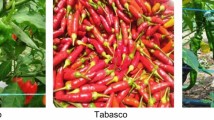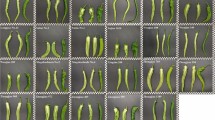Abstract
Hot pepper (Capsicum spp.) is an economically considerable crop, particularly appreciated for its nutritional properties and antioxidants content. Levels of the latter depend on several factors including the cultivar and the environment. In the present study, diversity in morpho-agronomic traits and phytochemical compounds was investigated in 14 hot pepper accessions cultivated in two different pedoclimatic locations. The main source of variation was due to the genotype which showed significant differences for all traits at both locations. With regard to the bioactive compounds, the environment accounted for over 30% of variation for carotenoids, ascorbic acid and tocopherols and less than 0.5% for capsaicinoids. A strong genotype × environment interaction (p < 0.01) was observed in all traits with the exception of those related to fruit weight and shape. Genotyping by sequencing was used for molecular analysis revealing a total of 2120 single-nucleotide polymorphisms. Diversity on the basis of hierarchical clustering and structure analysis elucidated the relationships among accessions on the basis of their biological status and common ancestors, suggesting their contribution to the phenotypic performances observed. The comprehensive approach of this study provides useful information on the variability of phytochemicals mediated by the environment, revealing the challenge related to the genetic improvement of bioactive compounds. The integration of phenotypic and molecular data provides information to identify interesting hot pepper accessions to select for breeding programmes.



Similar content being viewed by others
References
The Plant List (2018) http://www.theplantlistorg/tpl11/search?q=capsicum. Accessed 07 Nov 2017
Bosland PW, Walker SJ (2010) Measuring chile pepper heat Guide-237 New Mexico State University. http://aces.nmsu.edu/pubs/_h/h-237.pdf. Accessed 12 Feb 2017
Sun T, Xu Z, Wu CT, Janes M, Prinyawiwatkul W (2007) Antioxidant activities of different colored sweet bell peppers (Capsicum annuum L). J Food Sci 72:98–102
Prasad BCN, Shrivastava R, Ravishankar GA (2005) Capsaicin: a promising multifaceted drug from Capsicum spp. Evid Based Integr Med 2:147–166
Silva LR, Azevedo J, Pereira MJ, Valentão P, Andrade PB (2013) Chemical assessment and antioxidant capacity of pepper (Capsicum annuum L.) seeds. Toxicol Food Chem 3:240–248
Howard LR, Talcott ST, Brenes CH, Villalon B (2000) Changes in phytochemical and antioxidant activity of selected pepper cultivars (Capsicum species) as influenced by maturity. J Agr Food Chem 48:1713–1720
Estrada B, Bernal MA, Díaz J, Pomar F, Merino F (2002) Capsaicinoids in vegetative organs of Capsicum annuum L in relation to fruiting. J Agr Food Chem 50:1188–1191
Marin A, Ferreres F, Tomas F (2004) Characterization and quantitative of antioxidant constituents of sweet peppers. J Agr Food Chem 52:3861–3869
Deschamps S, Llaca V, May GD (2012) Genotyping-by-sequencing in plants. Biology 1:460–483
Taranto F, D’Agostino N, Greco B, Cardi T, Tripodi P (2016) Genome-wide SNP discovery and population structure analysis in pepper (Capsicum annuum) using genotype-by-sequencing. BMC Genom 17:943
Collins MD, Wasmund LM, Bosland PW (1995) Improved method for quantifying capsaicinoids in Capsicum using high-performance liquid chromatography. HortSci 30:137–139
Barbero GF, Palma M, Barroso CG (2006) Determination of capsaicinoids in peppers by microwave-assisted extraction-high-performance liquid chromatography with fluorescence detection. Anal Chim Acta 578:227–233
Hornero-Méndez D, Mínguez-Mosquera MI (2001) Rapid spectrophotometric determination of red and yellow isochromic carotenoid fractions in paprika and red pepper oleoresins. J Agr Food Chem 49:3584–3588
Picchi V, Migliori C, Lo Scalzo R, Campanelli G, Ferrari V, Di Cesare LF (2012) Phytochemical content in organic and conventionally grown Italian cauliflower. Food Chem 130:501–509
Gnayfeed MH, Daood HG, Biacs PAm Alcaraz CF (2001) Content of bioactive compounds in pungent spice red pepper (paprika) as affected by ripening and genotype. J Sci Food Agr 81:1580–1585
Meckelmann SW, Riegel DW, van Zonneveld M, Ríos L, Peña K, Mueller-Seitz E, Petz M (2015) Capsaicinoids flavonoids tocopherols antioxidant capacity and color attributes in 23 native Peruvian chili peppers (Capsicum spp) grown in three different locations. Eur Food Res Technol 240:273–283
Kumar S, Stecher G, Tamura K (2016) MEGA7: molecular evolutionary genetics analysis 70 for bigger datasets. Mol Biol Evol 33:1870–1874
Pritchard JK, Stephens M, Donnelly P (2005) Inference of population structure using multilocus genotype data. Genetics 155:945–959
Earl DA, vonHoldt BM (2012) STRUCTURE HARVESTER: a website and program for visualizing STRUCTURE output and implementing the Evanno method. Conserv Genet Resour 4:359–361
Evanno G, Regnaut S, Goudet J (2005) Detecting the number of clusters of individuals using the software STRUCTURE: a simulation study. Mol Ecol 14:2611–2620
Curtin F, Schulz P (1998) Multiple correlations and Bonferroni’s correction. Biol Psychiatry 44:775–777
Gao J, Tarcea VG, Karnovsky A, Mirel BR, Weymouth TE, Beecher CW, Cavalcoli JD, Athey BD, Omenn GS, Burant CF, Jagadish HV (2010) Metscape: a Cytoscape plug-in for visualizing and interpreting metabolomic data in the context of human metabolic networks. Bioinformatics 26:971–973
Mantel NA (1967) The detection of disease clustering and a generalized regression approach. Cancer Res 27:209–220
Gurung T, Techawongstien S, Suriharn B, Techawongstien S (2011) Impact of environments on the accumulation of Capsaicinoids in Capsicum spp. HortSci 46:1576–1581
Butcher JD, Crosby KM, Yoo KS, Patil BS, Ibrahim AMH, Leskovar KI, Jifon JL (2012) Environmental and genotypic variation of capsaicinoid and flavonoid concentrations in Habanero (Capsicum chinense) peppers. HortScience 47:574–579
Gurung T, Techawongstien S, Suriharn B, Techawongstien S (2012) Stability analysis of yield and capsaicinoids content in chili (Capsicum spp) grown across six environments. Euphytica 187:11–18
Zewdie Y, Bosland PW (2000) Evaluation of genotype environment and genotype-by-environment interaction for capsaicinoids in Capsicum annuum L. Euphytica 111:185–190
Giuffrida D, Dugo P, Torre G, Bignardi C, Cavazza A, Corradini C, Dugo G (2013) Characterization of 12 Capsicum varieties by evaluation of their carotenoid profile and pungency determination. Food Chem 140:794
Wahyuni Y, Ballester AR, Sudarmonowati E, Bino RJ, Bovy AG (2011) Metabolite biodiversity in pepper (Capsicum) fruits of thirty-two diverse accessions: variation in health-related compounds and implications for breeding. Phytochemistry 72:1358–1370
Reddy UK, Almeida A, Abburi VL, Alaparthi SB, Unselt D, Hankins G, Park M, Choi D, Nimmakayala P (2014) Identification of gene-specific polymorphisms and association with capsaicin pathway metabolites in Capsicum annuum L collections. PLoS One 9:1–10
Bosland PW, Votava EJ, Votava EM (2012) Peppers: vegetable and spice capsicums. Crop Production Science in Horticulture Series 22 Wallingford UK CABI, p 248
FDA Guidance for Industry: A Food Labeling Guide (2013) http://wayback.archive-it.org/7993/20171104063841/https://www.fda.gov/Food/GuidanceRegulation/GuidanceDocumentsRegulatoryInformation/LabelingNutrition/ucm064928.htm . Accessed 07 Feb 2018
Campos M, Gómez K, Ordoñez Y, Ancona D (2013) Polyphenols ascorbic acid and carotenoids contents and antioxidant properties of habanero pepper (Capsicum chinense). Fruit Food Nutr Sci 4:47–54
Kantar MB, Anderson JE, Lucht SA, Mercer K, Bernau V, Case KA, Le NC, Fredericksen MK, DeKeyser HC, Wong ZZ, Hastings JC, Baumler DJ (2016) Vitamin Variation in Capsicum Spp provides opportunities to improve nutritional value of human diets. PLoS ONE 11:e0161464
Vega-Galvez A, Di Scala K, Rodriguez K, Lemus-Mondaca R, Miranda M, Lopez J, Perez-Won M (2009) Effect of air-drying temperature on physico-chemical properties antioxidant capacity colour and total phenolic content of red pepper (Capsicum annuum L var Hungarian). Food Chem 117:647–653
Yahia EM, Contreras-Padilla M, Gonzalez-Aguilar G (2001) Ascorbic acid content in relation to Ascorbic acid oxidase activity and polyamine content in Tomato and Bell Pepper fruits during development maturation and senescence. Lebensm Wiss u Technol 34:452–457
Arimboor R, Natarajan RB, Menon KR, Chandrasekhar LP, Moorkoth V (2015) Red pepper (Capsicum annuum) carotenoids as a source of natural food colors: analysis and stability a review. J Food Sci Technol 52:1258–1271
Koch M, Arango Y, Mock HP, Heise KP (2002) Factors influencing α-tocopherol synthesis in pepper fruits. J Plant Physiol 159:1015–1019
Lachman J, Hejtmánková A, Orsák M, Popov M, Martinek P (2018) Tocotrienols and tocopherols in colored-grain wheat tritordeum and barley. Food Chem 240:725–735. https://doi.org/10.1016/jfoodchem201707123
Lee JJ, Crosby KM, Pike LM, Yoo KS, Leskovar DI (2005) Impact of genetic and environmental variation on development of flavonoids and carotenoids in pepper (Capsicum spp). Sci Hortic 106:341–352
Keyhaninejad N, Richins RD, O’Connell MA (2012) Carotenoid content in field-grown versus greenhouse-grown peppers: different responses in leaf and fruit. HortScience 47:852–855
Falk J, Munne-Bosch S (2010) Tocochromanol functions in plants: antioxidation and beyond. J Exp Bot 61:1549–1566
David P (1998) Heterozygosity-fitness correlations: new perspectives on old problems. Heredity 80:531–553
Acknowledgements
The work was supported by ‘PEPIC’ project funded by the Italian Ministry of Agriculture, Food and Forestry and the ‘GenHort’ project funded by the Italian Ministry of University and Research (MIUR, PON02_00395_3215002). The authors wish to acknowledge the students of the Agricultural High School ‘Vilfredo Pareto’ of Milan for technical support in the chemical analysis.
Author information
Authors and Affiliations
Corresponding author
Ethics declarations
Conflict of interest
There are no conflicts of interest to declare.
Human and animal participant rights
This article does not contain any studies with human participants or animals performed by any of the authors.
Electronic supplementary material
Below is the link to the electronic supplementary material.
Rights and permissions
About this article
Cite this article
Tripodi, P., Cardi, T., Bianchi, G. et al. Genetic and environmental factors underlying variation in yield performance and bioactive compound content of hot pepper varieties (Capsicum annuum) cultivated in two contrasting Italian locations. Eur Food Res Technol 244, 1555–1567 (2018). https://doi.org/10.1007/s00217-018-3069-5
Received:
Revised:
Accepted:
Published:
Issue Date:
DOI: https://doi.org/10.1007/s00217-018-3069-5




